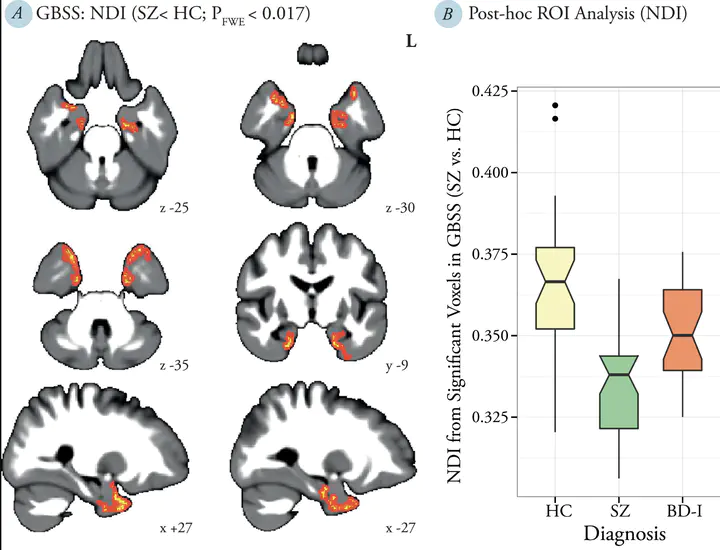
Abstract
Postmortem studies have demonstrated considerable dendritic pathologies among persons with schizophrenia and to some extent among those with bipolar I disorder. Modeling gray matter (GM) microstructural properties is now possible with a recently proposed diffusion-weighted magnetic resonance imaging modeling technique neurite orientation dispersion and density imaging. This technique may bridge the gap between neuroimaging and histopathological findings. We performed an extended series of multishell diffusion-weighted imaging and other structural imaging series using 3T magnetic resonance imaging. Participants scanned included individuals with schizophrenia (n = 36), bipolar I disorder (n = 29), and healthy controls (n = 35). GM-based spatial statistics was used to compare neurite orientation dispersion and density imaging-driven microstructural measures (orientation dispersion index and neurite density index, NDI) among groups and to assess their relationship with neurocognitive performance. We also investigated the accuracy of these measures in the prediction of group membership, and whether combining them with cortical thickness and white matter fractional anisotropy further improved accuracy. The GM-NDI was significantly lower in temporal pole, anterior parahippocampal gyrus, and hippocampus of the schizophrenia patients than the healthy controls. The GM-NDI of patients with bipolar I disorder did not differ significantly from either schizophrenia patients or healthy controls, and it was intermediate between the two groups in the post hoc analysis. Regardless of diagnosis, higher performance in spatial working memory was significantly associated with higher GM-NDI mainly in the frontotemporal areas. The addition of GM-NDI to cortical thickness resulted in higher accuracy to predict group membership. GM-NDI captures brain differences in the major psychoses that are not accessible with other structural magnetic resonance imaging methods. Given the strong association of GM-NDI with disease state and neurocognitive performance, its potential utility for biological subtyping should be further explored.